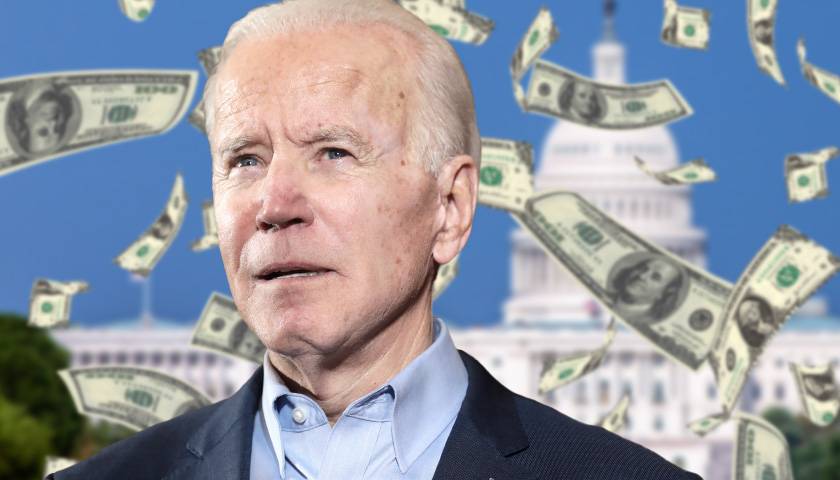by Jeffrey H. Anderson
When Joe Biden delivers the State of the Union Address on Tuesday night, at least three things seem pretty certain. He’ll suggest America is now in its Golden Age, no doubt begun sometime in late January 2021. He’ll offer a laundry list of new things on which he’d like to have the government spend Americans’ hard-earned money. And he won’t say a thing about how we’re now $31.4 trillion in debt—roughly triple the $10.6 trillion tally from when Biden became vice president just 14 years ago.
Meanwhile, Bill Clinton’s former Secretary of Labor Robert Reich has written an article at the Guardian claiming “Republicans aren’t going to tell Americans the real cause of our $31.4 [trillion] debt.” Reich says the real cause is insufficient taxation, specifically on the rich.
In the wake of the Trump tax cuts, however, federal revenues reached an all-time high in 2021—even after adjusting for inflation—before that record was promptly broken again in 2022. Nevertheless our debt keeps rising, and spectacularly so. It would seem that we have a spending problem, not a taxing problem.
To help make this and other points clear, the American Main Street Initiative (which I founded and run) has just released its first issue of Quick Hits, and the inaugural issue is focused on the national debt. A printable four-pager that’s both easily readable and chock-full of information, this issue of Quick Hits is based on my Claremont Review of Books essay, “In the Red.” It provides an overview of how bad our debt situation is, how we got here, and how we can get ourselves out of this mess.
The problem certainly isn’t insufficient taxation. In 2021, the federal government collected more than three-and-a-half times as much money, in real dollars per capita—that is, above and beyond inflation and population growth—as it did at the start of the post-World War II period. But it spent nearly seven times as much. Spending nearly seven times as much, per American, in real (inflation-adjusted) dollars, is no easy feat. What is the federal government spending all of that money on?
It’s not primarily defense. Another frequent claim on the Left is that our debt has resulted from bloated defense budgets that started with the Reagan Administration. In truth, however, real per capita defense spending—that is, defense spending per American, after adjusting for inflation—fell from $2,283 in 1962 to $1,953 in 2020. Meanwhile, real per capita spending on everything but defense rose more than eight-fold (from $1,930 in 1962 to $15,646 in 2020). (That’s right: in 1962, under President Kennedy, defense accounted for more than half of all federal spending. Even at the height of the Reagan defense buildup, we exceeded 1962’s real per capita defense spending by only 2 percent.) That’s based on official federal statistics.
While real per capita defense spending has dropped, Great Society spending has skyrocketed. To quote Quick Hits, “In real per capita spending, we spent more than five times as much on defense in 1975 as on Medicare and Medicaid combined. By 2019, we spent 56% more on Medicare and Medicaid than on defense.” What’s more, “In 1975, the costs of Medicare and Medicaid consumed 7% of all federal tax revenues. In 2019, they cleared 30%.”
Indeed, about 70 percent of our spending—consuming about 90 percent of our tax revenues—is now on autopilot. Congress doesn’t even actively control such “mandatory” spending (although it could). Instead, this broken autopilot system is flying not only the plane but also the country into the ground.
The problem is that when President Lyndon Johnson and his congressional allies launched the Great Society programs in the mid-1960s, they had no plan to pay for them. Unlike Social Security, which has a dedicated and generally sufficient revenue stream, Medicare and Medicaid (and Obamacare, part of which expanded Medicaid) do not have a dedicated revenue stream that comes anywhere close to covering costs.
The results haven’t been pretty. The first year that Medicare spending visibly hit the books was 1967. From that point through 2020, Medicare and Medicaid cost a combined $17.8 trillion, while our combined federal deficits over that same span were $17.9 trillion. In essence, our deficit problem is a Medicare and Medicaid problem.
It’s helpful to trace our debt levels over time. At the end of World War II, the federal government owed $3 trillion of debt held by the public in constant 2012 dollars (up from about $700 billion when the war began). Subsequent statesmen succeeded in cutting that tally in half by 1974 (to $1.5 trillion), but (as the Great Society programs ramped up) it rose back to end-of-World-War-II levels by 1986 (to $3 trillion), doubled end-of-World-War-II levels by 2008 ($6 trillion), tripled them by 2010 ($9 trillion), quadrupled them by 2014 ($12 trillion), quintupled them by 2019 ($15 trillion), and sextupled them by 2020 ($18 trillion). So, the debt we owe to the public (with significant amounts owed to the Chinese) is now 12 times as high as in 1974—even after adjusting for inflation. (This is visually depicted in a Quick Hits chart.)
Things have gotten particularly bad in very recent years. In 2020 alone, the federal government racked up more deficit spending than it had during the first 36 fiscal years of the postwar era combined (1947 through 1982), and that’s even after adjusting for inflation. As a result of this fiscal profligacy, we racked up more debt held by the public in the 12 months of 2020 than we did during the four years of World War II—again, even after adjusting for inflation. And then we spent even more in 2021 than we did in 2020.
In terms of spending the most money—even after adjusting for inflation—our all-time gold medal year is 2021, with 2020 winning the silver and 2022 taking the bronze. Biden calls this progress.
Indeed, if Biden does say anything about deficits or debt in the State of the Union, he’ll likely claim they’ve dropped on his watch. But as I wrote in a letter to the editor to the Wall Street Journal in the fall, “The Congressional Budget Office says that the American Rescue Plan Act [ARPA], spearheaded and signed by Mr. Biden, added $1.1 trillion in deficit spending in 2021. So, Mr. Biden drove up the 2021 deficit by a huge margin and then bragged about spending less the next year.”
In just the first 20 months of his tenure (through September 2022), Biden and the Democratic Congress were already responsible for $2.5 trillion in deficit spending ($1.1 trillion for the American Rescue Plan Act in 2021 and $1.4 trillion overall in 2022). To put that number into perspective, when Ross Perot ran for president and rightly complained that our deficits were out of control, our national debt—accumulated across the first 203 years of our government’s existence under the Constitution—was $4 trillion.
To add further perspective, we’ve already racked up about as much debt under Biden as we did during all of World War II—even after adjusting for inflation. Then, American servicemen were fighting a two-front war for the survival of liberty. Now, our government is just spending like a drunken sailor.
– – –
Jeffrey H. Anderson is president of the American Main Street Initiative and served as director of the Bureau of Justice Statistics at the U.S. Department of Justice from 2017 to 2021.
Photo “Joe Biden” by Gage Skidmore. CC BY-SA 2.0. Background Photo “U.S. Capitol” by Thuan Vo.




